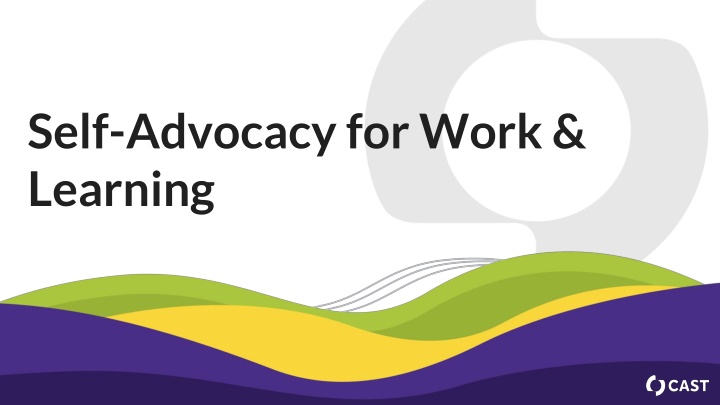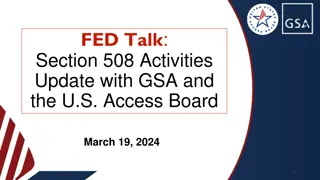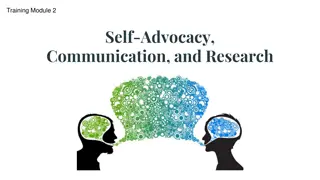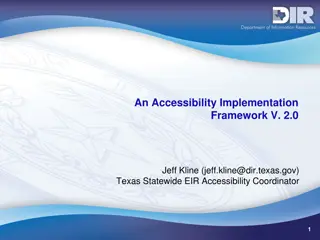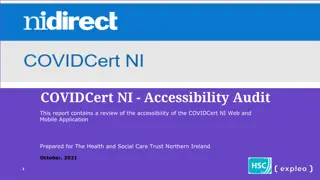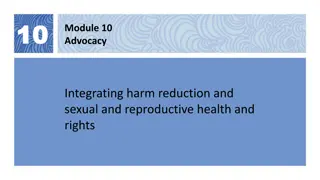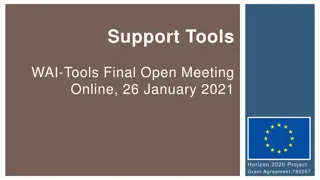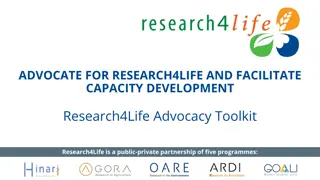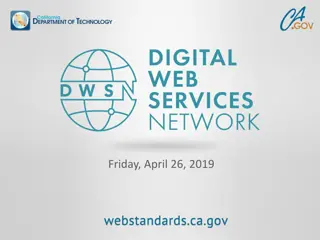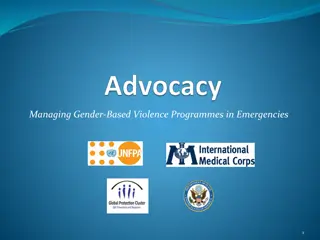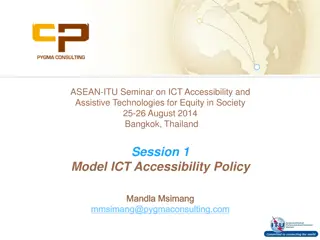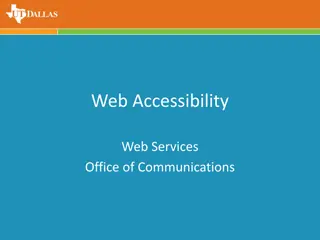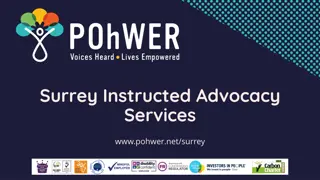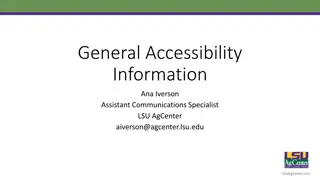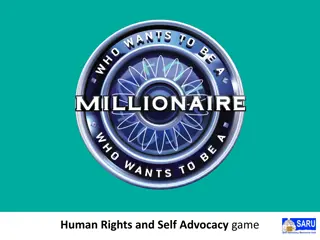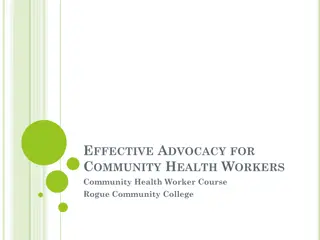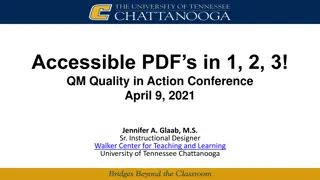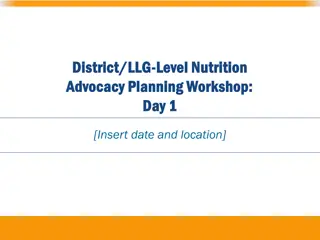Self-Advocacy for Work & Learning Accessibility Resources
This resource provides valuable information on self-advocacy for work and learning, along with accessibility statements, language considerations, and additional technologies to enhance learning experiences. It emphasizes inclusivity, respect, and support for diverse learning differences. Users can access practical tips, guidelines, and tools to navigate work and learning environments effectively while promoting accessibility and understanding for all individuals.
Download Presentation

Please find below an Image/Link to download the presentation.
The content on the website is provided AS IS for your information and personal use only. It may not be sold, licensed, or shared on other websites without obtaining consent from the author.If you encounter any issues during the download, it is possible that the publisher has removed the file from their server.
You are allowed to download the files provided on this website for personal or commercial use, subject to the condition that they are used lawfully. All files are the property of their respective owners.
The content on the website is provided AS IS for your information and personal use only. It may not be sold, licensed, or shared on other websites without obtaining consent from the author.
E N D
Presentation Transcript
Self-Advocacy for Work & Learning
Creative Commons Resource created by CAST and licensed under a Creative Commons Attribution-NonCommercial-NoDerivatives 4.0 International License. All other rights reserved related to third- party content. Resource contact: workforce@cast.org.
Accessibility Statement CAST is committed to accessibility as a foundational component of the Universal Design for Learning framework. In developing the content for these modules, we followed accessibility best practices informed by the Web Content Accessibility Guidelines (WCAG), the international accessibility standard. For example, we provided alternative text for the images and captions for any embedded videos and checked for color contrast. We want to make sure you gain the best learning experience possible. Should you encounter any accessibility or usability barriers as you navigate the course content, please contact us at workforce@cast.org. This course is delivered through the LINCS Learning Portal. Should you encounter any accessibility challenges related to the design of the LINCS Learning Portal, please contact the LINCS team.
Language We recognize that language is fluid and evolves over time to reflect the influence of the society and culture we each live in. We also recognize that our personal experiences are unique, and they too influence the way we interpret and use language. Throughout these modules, we use the term learning difference to refer to the variability each person brings to the learning environment and which we want to celebrate and support with UDL. We also want to acknowledge the many contributions of the disability rights community. In that spirit, we will use the terms learning difference and learning disability interchangeably and lean toward disability when we are referencing specific laws or the disability rights movement. Our intention is first and foremost to show respect for person. We encourage you to consult with your adult learners and to use the language that is most welcoming and respectful to them.
Additional Technologies The option to resize text is available in most browsers with a keyboard shortcut: Control (or Command on the Mac) and + (plus) to zoom in Control (or Command on the Mac) and - (minus) to zoom out Control (or Command on the Mac) and 0 (zero) to reset the zoom level to the default (100%). You can also find these options in the browser's menus, usually under View. Along with other display options, a read-aloud feature is now built into many operating systems and can be configured in the system preferences. To learn more about these options, visit the Personalizing the Reading Experience page on the AEM Center website at CAST.
Free Feature-Rich Screen Readers Should you need to use a more feature-rich screen reader to access the content, several free options are available: VoiceOver is built-in on Mac computers and iOS devices such as the iPhone and iPad Narrator is built-in on Windows computers and tablets, and NVDA is available as a free download ChromeVox is available on Chromebooks TalkBack is built-in on Android phones and tablets, and a version of it is also available on Amazon s Fire tablets (called VoiceView)
Background Knowledge (1 of 3) Each module has been designed using the Universal Design for Learning (UDL) framework. We have included the following videos, definitions, and resources to help you understand the overall goals of the project and to ensure you have the context and content you need to understand the material: Universal Design for Learning (UDL) is a research-based framework that reduces barriers to learning by providing flexibility in the ways learners can engage with, perceive, and demonstrate understanding. The UDL guidelines are a tool filled with concrete steps educators can use to make use of the framework. Video Title: OCTAE & CAST: Improving ABE Duration: 1min 23sec Transcript [link to come]
Background Knowledge (2 of 3) Language: We recognize that language is fluid and evolves over time to reflect the influence of the time and culture we each live in. We also recognize that our personal experiences are unique, and they too influence the way we interpret and use language. Throughout these modules, we use the term learning difference to refer to the variability each person brings to the learning environment and which we want to celebrate and support with UDL. Video Title: Travis Combs Explains Key Project Goals and Outcomes Annotated Bibliography: This document contains the initial list of references the team analyzed to develop these modules. While they may not be directly cited in the modules, they informed the creation of the content. Duration: 1min 50sec [Link to Transcript]
Background Knowledge (3 of 3) Voices from the field: The videos in this playlist appear here and throughout other modules in this series. They include interviews with ABE learners, educators, experts, and administrators. Please feel free to use these CAST-created videos under a Creative Commons Attribution- NonCommercial-NoDerivatives 4.0 International License. All other rights reserved related to third-party content. Resource contact: workforce@cast.org. Key organizations: Consider becoming a member of these key organizations. By attending conferences and reading relevant new literature you can constantly improve your teaching practice and collaborate with other educators in your field: Coalition on Adult Basic Education and Council for Adult and Experiential Learning.
1. Introduction 1. Introduction The purpose of this module is to introduce you to two key terms: self-advocacy and learner agency. Learner agency is a term that stresses the importance of students being active learners who can make choices and control their own learning experiences. Self-advocacy is a term used to describe learners' ability to communicate their own needs within the learning process. All learners will need to become self-advocates in both the classroom and at work (asking for what they need) and educators will need to teach them how by creating classrooms that directly facilitate and build learner agency.
Module Structure This module is structured into five sections. You'll find Key Ideas, Pro Tips, Try it Yourself, and Resources linked throughout the text. All the linked materials are gathered, along with References, in Section 4. This way, you can choose to learn more in the moment, or wait until you complete the core content. 1. Introduction 2. Challenge 3. New Learning 4. Wrap-Up This module will introduce you to the concepts of "learner agency" and "self-advocacy" and to the value they bring to the classroom. After this module, you will feel better equipped to help learners build their own agency for work and learning. 5. Assessment Additional Resource: Learn more about our inspiration, How People Learn Framework and the STAR Legacy Model
Module Goals Our Purpose: The purpose of this module is to learn how self-advocacy skills support adult learners' sense of agency and improve career outcomes for all learners, especially those with learning differences and disabilities. Your Task: Your task is to reflect on the ways your teaching practices and strategies increase learner agency and connect self-advocacy skills to positive career outcomes. Wrap-Up: During the final sections of the module, you will be asked to review your initial understanding and reflect on how the new learning will use best practices to support learners to develop self-advocacy skills. By comparing what you thought at first to what you think now. Through this process, you will be able to see your own growth and development. You will also have the opportunity to complete an assessment to receive a certificate of completion.
2. Challenge 2. Challenge Agency is understanding the value we bring to a classroom or workplace. To do this, we are going to consider a problem or challenge in the form of a case study. A case study is a teaching tool educators use to introduce a concept by sharing a real-world situation. At the close of the module, we will remind you of the challenge and ask you to reflect on your initial responses to see if you have changed your thinking or might incorporate any of the new material you learned in the module. Make sure to keep track of your first ideas. Use pen and paper, digital note-taking, or a video or audio recording of your thoughts; whichever allows you to best reflect.
Case Study: Lifelong Learning Rhandi Berth is a nationally recognized workforce development specialist. For more than 24 years, she has been helping develop workforce intermediary and industry partnerships in the manufacturing industry. Rhandi's focus is on helping adult learners find success at work. She is especially interested in making sure high-wage, high-skill careers like those in manufacturing provide training pathways for women and people from diverse backgrounds. In this video, Rhandi explores what it means to build learner agency by encouraging "lifelong" learning. Rhandi also highlights some of the issues that can come up when training happens in the workplace. Play the video or read the transcript in preparation for your challenge. Video Title: Rhandi Berth and Lifelong Learning in the Workplace Pro Tip: Use case studies in your instruction. Duration: 1min 06sec Transcript: [link to transcript]
Here's Your Challenge Rhandi identifies how "cultural differences" can get in the way of training programs in the workplace. What do you think? Can you relate to what Rhandi is saying? Do you agree or disagree with her statements? What would you like to know more about? How do you think learner agency results in lifelong learning? What advice would you give to a new employee who doesn t feel understood by the person training them? Video Title: Rhandi Berth and Lifelong Learning in the Workplace What advice would you give to a trainer who is going to be responsible for onboarding/training new employees in today's workforce? Duration: 1min 06sec Transcript: [link to transcript] Try it Yourself: Case-based Learning
3. New Learning 3. New Learning Your task in this module is to assess how the adult learners in your classroom currently experience agency and to develop learners' self-advocacy skills for use in the workplace. Developing adult learners' sense of agency and ownership of learning is a key goal of andragogy, or the practice of teaching adults.
Key Idea: Connect learning to self-development. We often think this type of teaching is effective because adult learners sit politely during a lecture, or we assume they already know how to learn. It's not. Understanding the minds of adult learners and what motivates them is called Andragogy. Learning about the ways adults learn and how they are different from the ways children learn will help you design more effective, motivating, and engaging learning experiences for all learners in your classroom.
Adults Need Instruction Tailored to the Way They Learn (1 of 3) Adult learners need instruction that is tailored to meet their needs and self-development. Watch the video, Principles of Andragogy, and review these key principles to keep in mind when teaching adults: 1. The learner's need to know: Adults need to know how the new information is going to benefit them right away. Frame learning to identify how it will make their work or life easier, better position them for a promotion, help them be better caregivers, etc. Video Title: Principles of Andragogy Duration: 2min 26sec 2. Self-directed learning: Adults don't want to be micromanaged. Instead, they prefer opportunities for independent thinking and the freedom to choose how they approach the need to learn something new.
Adults Need Instruction Tailored to the Way They Learn (2 of 3) 3. Prior learning experience: Adults have already lived complex lives and had personal experiences. These experiences may cause them to resist new learning. Resistance can be overcome by addressing the principles of andragogy being introduced here. Rember the principals of Andragogy The learners needs to know Self-directed learning Prior learning experience Readiness to learn 4. Readiness to learn: Adults become ready to learn when they have a need to learn. A new job, career change, or circumstance can provide incentive for adults to engage with new material. Also, be aware and sensitive to the barriers adults may face when it comes to new learning. A current career and family can make it difficult to balance new learning. Orientation to problem-solving and learning Motivation to learn
Adults Need Instruction Tailored to the Way They Learn (3 of 3) 5. Orientation to learning and problem solving: Adults prefer problem-solving instead of subject learning. When the problem is related to a real- world events, such as something they encounter in their daily life (i.e., budgeting, reading the news, taking care of their children), adults are more readily engaged. Remember the principals of andragogy The learners needs to know Self-directed learning Prior learning experience Readiness to learn 6. Motivation to learn: Adults want to enjoy the learning process and feel that the knowledge or experience benefits their lives in some way. Orientation to problem-solving and learning Motivation to learn Try it Yourself: Introduce learners to the differences between teaching adults and teaching children.
Key Idea: Agency can be developed. Agency is the feeling that a learner can independently: Make their own choices Share their experiences and beliefs Be valued within a learning environment o o o Many adult learners, especially those with learning differences, will enter your classroom with very little feelings of agency. By showing learners that agency can be developed and then creating agency-building experiences for adults, you will increase learners' success in academics and in the workplace.
Barriers to Building Learner Agency: Learner Perspective There are both external and internal barriers to learner agency. Examples of external barriers include: Changes in the learners roles as employee, parent, caregiver, etc. Changes in capacity, based on age and/or disability Changes in employment status and/or employer requirements Examples of internal barriers include: Limited exposure to different perspectives on issues impacting their lives Over-dependence on learned facts and skills Difficulty in managing focus Anxiety related to past educational experiences
Barriers to Building Learner Agency: Educator Perspective Just like learners, educators can have their own barriers to agency. Examples of barriers for educators include: Limited time to properly plan and prepare lessons and activities Large class sizes that may limit their ability to focus on the needs of individual learners Anxiety about their own ability to teach adult learners, including their ability to address problematic or challenging class dynamics Try it Yourself: Reflect on your own practice and uncover barriers for building learner agency.
Motivational Interviewing Motivational interviewing is a collaborative, person-centered form of guiding adult learners to share experiences. Through this process, educators can elicit and strengthen motivation for change and increase adults' sense of agency. The acronym used in motivational interviewing is OARS: O: open-ended questions A: affirmations R: reflections S: summaries Additional Resource: Usefulness of a Positive Psychology Motivational Interviewing Intervention
Motivational Interviewing In this video, Michael Cruse talks about how he uses motivational interviewing to "learn about adult learners." Watch the video and pause to reflect on the following prompts: I can relate to I agree/disagree... I'd like to know more about... Video Title: Michael Cruse and Connecting Through Conversation Try it Yourself: Motivational Interviewing Duration: 2min 26sec Additional Resource: Using Motivational Interviewing in a Goal-Setting Process Transcript: [Link to Transcript]
Key Idea: Self-reflection builds self-awareness and leads to learner agency. Prior negative experiences in education can lead adult learners to feel unprepared to take responsibility for their learning. Introducing habits of self-reflection helps learners build greater self-awareness, which includes both one's strengths and needs for support. An increase in learners self-awareness is associated with increases in their self- knowledge. This leads to increases in the accuracy of their self-appraisal and builds feelings that learners can make their own choices, share their experiences and beliefs, and feel valued in the learning and work environment (key characteristics of learner agency).
Building Agency for Adult Learners Self-awareness can be thought of as self-focused attention (e.g., see Carver, 2012). Self-awareness is considered a core competency of Social-Emotional Learning (SEL) by the Collaborative for Academic, Social, and Emotional Learning (CASEL). This definition highlights a fundamental function of self-awareness: Focusing attention on yourself induces a comparison between your current state and the goal state you are pursuing. Highlighting adult learners rights and responsibilities, helping them see the value of their own life experiences, and explaining the ways you design the learning experiences to meet the specific needs of adult learners (andragogy) builds agency for all learners. Equipping adult learners with this information will be especially helpful to people with learning differences who may have had negative experiences with education in the past. Try it Your Self: Micro-credential from Digital Promise.
Building Self-Awareness: VanMuijen Emotion Wheel Example of how the VanMuijen Emotion Wheel could be used: Sarah uses the VanMuijen Emotion Wheel with her ABE students every week for two months. After reflecting with the adult learners on their responses and comparing the data to their ability to focus on learning, she makes some changes to her classroom. For example, she starts bringing snacks, includes more breaks, and even introduces meditative breathing techniques. The participants are also able to notice some patterns. One man verbalizes that he notices he is less able to focus on learning on the weekends when his kids are with their biological mom. Sarah spends time talking with her class about how they could use this information to advocate for their needs at work. Pro Tip: Include frequent and ongoing opportunities for self-reflection. Try it Yourself: Use the VanMuijen Wheel in Your Classroom.
Key Idea: Instructional practices impact learner agency. Instructional practices in this module come from the self-determination theory, which proposes that adult learners will do better in environments where they have: Control and choice (autonomy) Strong positive relationships with their peers and the teacher in the classroom (relatedness) An ability to effectively understand the materials they are learning (competence)
Instructional Practices: Autonomy For adult learners,' autonomy feels like independence and choice, the freedom to make decisions in the classroom. Adult learners will do better in classes where they can exercise choice, share opinions, and demonstrate skills in the ways they choose. Educators should ask themselves: What choice in terms of topic have I offered? To what extent is the adult learner engaged in the planning, timing, selection of tools, or format for demonstration of learning? What personal freedom have I provided to the learner within the current task? Try it Yourself: Co-design a rubric with learners.
Instructional Practices: Autonomy Examples Choice: Teachers provide learners with opportunities to make choices about the content and process of their work. Group Work: Teachers provide learners with opportunities to work in groups to learn and practice agency necessary for group success. Revision: Teachers provide adult learners with opportunities to revise assignments or tests after giving feedback. Learners' Self-Reflection: Teachers provide adult learners with opportunities to self-reflect using journals, logs, or other structured templates or tools. Learner-Led Instruction: Teachers provide adult learners with opportunities to demonstrate agency by leading instruction on a particular skill or concept.
Instructional Practices: Relatedness For adult learners, relatedness feels like belonging, inclusion, and acceptance. To accomplish this, educators should purposefully identify the value each learner brings into the classroom, then make sure all voices are heard and all adult learners are given the opportunity to engage in all activities. Educators should ask themselves: How have I shown learners that I know them as individuals in this task or lesson? At this exact moment, how do I know learners feel comfortable with each other and the task at hand? Have I designed the task or lesson so that all learners are able to physically, emotionally, and socially ask questions, share opinions, and demonstrate learning?
Instructional Practices: Relatedness Examples Feedback: Teachers provide adult learners with feedback and scaffold the process of learners asking for feedback. Goal Setting: Teachers help adult learners set goals to complete coursework while improving agency. Individual Conferences: Teachers hold one-on-one meetings with adult learners to discuss elements of learner agency and its relationship to academic work. Learner Voice: Teachers provide adult learners with opportunities to contribute to and provide feedback on key decisions in the classroom. Additional Resource: UDL Check Point 6.2 Support planning and strategy development Additional Resource: UDL Check Point 6.1 Guide appropriate goal-setting
Instructional Practices: Competence For adult learners,' competence feels like having the necessary skills, effort, values, and attitudes to engage in the learning. Adult learners will do better in classes where they feel capable. This doesn't mean they need to possess the required knowledge, it means rather, that the educator conveys a sense of support and that the skills, values, effort, and attitude the learners bring to the classroom are valued and necessary for the learning. Educators should ask themselves: Are all learners making progress toward the goal? What is the learners' confidence with completing the instructional goal? Have I completed or built in frequent check-ins to gauge learners' engagement and concentration levels? Are there any additional outside materials or resources that learners need to complete the
Instructional Practices: Competence Examples Harnessing Outside Opportunities: Teachers provide learners with opportunities to demonstrate agency outside the classroom and make connections between outside agency and its application in the classroom. Assessment: Teachers design formative and summative assessments to evaluate adult learner agency and/or to provide learners with extrinsic motivation to build agency. Verbal Cues: Teachers provide brief spoken prompts in real time to highlight or remind learners of behaviors that demonstrate agency. Direct Instruction: Teachers provide explicit instruction to develop skills related to adult learner agency. Scaffolding: Teachers provide learners with tools, strategies, and resources to help scaffold learners toward mastery of agency.
Instructional Practices: Managing Information We all struggle to keep critical chunks of information in our working memory, at different times, but for people with learning differences or learning and cognitive disabilities, (such as those with ADHD, Autism, etc.) it can be even harder. It is important for teachers to provide a variety of internal scaffolds and external organizational aids to help all learners keep information organized and in mind. Teaching learners how to manage information and helping them identify strategies, such as list making or setting reminders on their phones, will increase agency and allow them greater independence to plan and manage their workload, troubleshoot and solve problems, and communicate more effectively in education or workplace settings. Additional Resource: Job Accomodation Network, Executive Function Pro Tip: Use UDL strategies to support planning and goal setting.
Key Idea: Creating a safe environment impacts learner agency. One of the most important things a teacher can do is to create a safe space for learners. To do this, teachers need to reduce potential threats and distractions in the learning environment. When learners have to focus their attention on having basic needs met or avoiding a negative experience, they cannot concentrate on the learning process. While the physical safety of a learning environment is of course necessary, subtler types of threats and distractions must be attended to as well; what is threatening or potentially distracting depends on learners individual needs and background. Adult learners, for example, might not want to reveal their reading ability to peers they have just met, or they might be tentative when sharing pervious learning experiences in formal schooling due to underlying trauma.
Trauma Impacts Adult Learners "Many professors come to class assuming students are ready, willing, and able to learn. But, for adult learners, things outside the classroom can and do affect them. They may have had a child up all night with an illness; they may have a spouse or partner who is abusive; they may be working a job (or two) to make ends meet; they may be having problems in their workplace; they may be experiencing food scarcity or homelessness; they may not have been able to do the needed reading and studying because they have no time to themselves or are they are so tired they cannot take in the material. Yet, professors are not for the most part paying attention to what has happened to students in the days or nights before class. They just teach. They place the onus on learning on the students. (Gross, 2019) Additional Resource: Trauma Impacts Adult Learners: Here s Why Additional Resource: UDL check point 7.3, Minimize threats and distractions
Safe Environments: Trauma-Informed Teaching We live in a world filled with trauma, and its symptoms are often invisible or misunderstood. Losing paychecks, constant exposure to stress, unrelenting racialized violence, threat of eviction, deaths in families and communities, etc. In addition to the consequences of persistent and continuous social inequities, these are all potential triggers for heightened traumatic responses. Kathy Olesen-Tracey, Senior Director for Adult Education & Literacy, Illinois Community College Board, introduces the idea of trauma-informed programs and the steps of becoming more trauma aware, sensitive, and responsive. Video Title: Kathy Olesen-Tracey and Trauma-Informed Programs Duration: 3min 10sec Additional Resource: Cipriano & Pape: Building a Climate of Belonging in Schools [Link to Transcript]
Safe Environments: The ABE classroom Whether adult learners can articulate that they have experienced trauma or how, it is the teachers' responsibility to create a safe learning environment. To do this, teachers need to reduce potential threats and distractions in the learning environment. When learners must focus their attention on getting their basic needs met or avoiding a negative experience, they cannot concentrate on the learning process. Kathy Olesen-Tracey, Senior Director for Adult Education & Literacy, Illinois Community College Board, discusses how a safe learning environment can indirectly support unknown trauma in adult learners. Video Title: Kathy Olesen-Tracey and Safe Environments for ABE Learners Duration: 2min 44sec Additional Resource: Environments Filled with Saftey and Belonging, Turnaround For Children [Link to Transcript]
Safe Environments: Reducing Threats While the physical safety of a learning environment is necessary, subtler types of threats and distractions must be attended to as well; what is threatening or potentially distracting depends on learners individual needs and background. An English language learner might find language experimentation threatening, while some learners might find too much sensory stimulation distracting. The optimal instructional environment offers options that reduce threats and negative distractions for everyone to create a safe space in which learning can occur. You can help reduce threat by: Modeling: Teachers model agency to demonstrate it to learners in a meaningful context. Positive Reinforcement: Teachers provide positive reinforcement for demonstration of agency. Trauma-Informed Practices: Trauma produces symptoms, and it affects the capacity of individuals of all ages to learn and retain information. Educators should consider trauma-informed practices when designing learning experiences. Pro Tip: Use UDL to create a safe learning environment.
Safe Environment: Disclosure Depending on the environment, Adult Basic Education (ABE) learners might not feel comfortable disclosing a diagnosis of a disability. This is especially true for ABE learners at work. Disclosure can build agency, if the learner feels comfortable and has language they can honestly share about their experiences and their needs. It is important to help ABE learners understand their rights around disclosure and that they are the ones sharing and leading the conversation. Additional Resource: Legal Issues, Self-Disclosure, and Confidentiality
Disclosure & Agency Part of agency is understanding your strengths and needs, identifying your personal goals, knowing your legal rights and responsibilities, and being able to clearly communicating these to others. However, only 4% of people disclose a disability at work. This is because discloser is personal and can have unintended results. Educators should support learners by talking with them about their choices with disclosure. Additional Resource: Office of Disability Employment Policy Publications | Pueblo.gpo.go Additional Resource: Forbes, Only 4% of Employees Disclose a Disability
Key Idea: Expanding social networks builds self-advocacy. Remember, self-advocacy is a term used to describe learners' ability to communicate their own needs within the learning process. Social networks are important for adult learners because they create forums where learners can share their needs and ideas with others. Social networks provide adult learners with a space to practice self-advocacy. Creating opportunities for adult learners to develop their social network can be done both in-person and virtually.
Strategies for Expanding Social Networks: In-Person Informational and mock interviews, class speakers, field trips, and volunteer engagement opportunities can help learners develop new social networks and practice their self-advocacy skills. Interviews: Can be part of a research or writing assignment. They can also be used as part of a career exploration activity. Developing questions in advance with learners and practicing them is a good opportunity to build confidence and presentation skills. Class Speakers: Can be invited to speak to classes on relevant topics. Speakers provide context to learning objectives and present the opportunity to ask relevant questions on a topic. Field Trips: Can also be used to connect to local businesses and organizations. Meeting with representatives from these institutions can give learners the opportunity to practice presentation skills. Service-Learning: Can be used to connect with local organizations and the communities they serve. Additional Resource: Digital Promise, Observation/Shadowing
Strategies for Expanding Social Networks: Virtual Virtual platforms can provide opportunities for adult learners to network and practice their self- advocacy skills through: Group challenges or projects that include interactive experiences, guided lessons, immersive activities, and live chats and discussions. The use of online bulletin boards, discussion boards, and polls that can be completed outside of class time. Participating in virtual job interviews. Additional Resource: Digital Promise, Peer Discussion Additional Resource: Improving Systems for Adult Education
Strategies for Expanding Social Networks: Service- Learning Service learning is a way for learners to expand their social network while receiving credit. Service Learning involves almost any helping activity and can include: Direct service-learning is getting involved firsthand with the recipient of the service. This includes tutoring, serving meals, working with patients, helping a refugee family, walking foster dogs, or participating in events at a nursing home. Many psychology and education courses incorporate direct service as a way of gaining hands-on experiences. Indirect service-learning is doing something behind the scenes or participating in and contributing to a process where the benefit or service may not be immediately recognizable. Examples include organizing a fundraising event, working in a resale shop, stocking a food pantry, collecting donations, or planting trees to help the environment. Advocacy service-learning is offering public support and can take the form of students writing letters to government officials, demonstrating in a picket line, or educating others about possible policy changes. Try it Yourself: Service-Learning
Key Idea: Metacognition builds learner agency and self-advocacy skills. Metacognition seems like a complicated idea, but in education metacognition simply means teaching learners to think about thinking. Metacognition is involved whenever we teach adult learners study skills or ask them to explain their thinking out loud to others. Learners with strong metacognitive skills are more effective and efficient in collaborating in small groups, can adjust their plans based on outcomes, are better able to select learning strategies that will lead to personal success, and can more effectively share their needs in classroom and workplace settings.
Explaining Their Thinking Research shows that summarizing or simply repeating what you have learned are less powerful strategies than explaining your thinking. Being asked to explain boosts reading skills, reinforces details, and helps learners move learning into long-term memory. Let's test the theory. Stop for a minute and imagine how you would explain metacognition to an Adult Basic Education (ABE) student. Now, write down why you decided to explain it this way. For example, did you focus on how metacognition supports learning? Or did you try to define it first? Additional Resource: Digital Promise, Explaining Their Thinking
Example: Building Metacognition Through Reading The Reading Apprenticeship Framework encompasses four overlapping dimensions: Social dimension Personal dimension Cognitive dimension Knowledge-building dimension Each dimension provides components to access and build metacognition through reading. Reading serves as a platform and context for learners to respond to and explore how they are thinking about the content they consume on social, personal, cognitive, and knowledge-building levels. Try it Your Self: Use the Reading Apprenticeship Framework to build metacognition.
